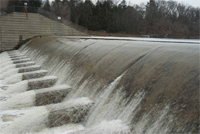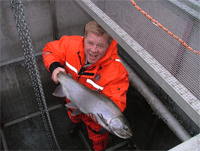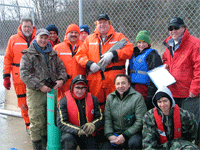About the Club
Club Activities
Hatchery Science
Hatchery
Newsletters
MEA in the News
Resources
- Ministry of Natural Resources
- Fishing Regulations
- Report a Poacher
- Ask the Conservation Officer
- Guide to Eating Sport Fish
Milne Fishway
In 1824, Peter and Alexander Milne acquired the property that today comprises the Milne Dam Conservation Area. They built a gristmill close to where the present dam now stands and the family ran the mill until 1933. Archie Milne built the first concrete and steel arc dam in Canada here and the town of Markham grew around this site. Today, the property is owned by the Toronto Region Conservation Authority and managed by the town of Markham.
The dam presented a barrier to fish passage into the upper reaches of the Rouge River. In 2001, construction of the present fishway began, by the Cornell Developer's Group, at a  cost of almost one million dollars. Construction was completed in 2003 and the fishway was put into full operation in 2005, opening up to migrating fish over 45km of river that was inaccessible until then. Thirteen species of fish, including Rainbow Trout, Brown Trout and Smallmouth Bass have been recorded as having ascended the fishway to proceed upstream.
cost of almost one million dollars. Construction was completed in 2003 and the fishway was put into full operation in 2005, opening up to migrating fish over 45km of river that was inaccessible until then. Thirteen species of fish, including Rainbow Trout, Brown Trout and Smallmouth Bass have been recorded as having ascended the fishway to proceed upstream.
The fishway is a twin Denil design, with a cage at the upstream end. During migration periods (predominantly in the spring), the cage is put in place to prevent the passage of undesirable species such as exotics and sea lamprey.  The latter is of major concern since the Milne Fishway is the last lamprey barrier to the upper Rouge River. Although lamprey are not very strong swimmers, they can navigate fishways by the use of their oral disk where they can attach themselves to smooth surfaces and incrementally progress through fast flows by alternating sprint swimming and attachment. To prevent their passage upstream and to allow for assessment of species passing through the fishway, the cage is in place and monitored on a regular basis during fish migratory periods.
The latter is of major concern since the Milne Fishway is the last lamprey barrier to the upper Rouge River. Although lamprey are not very strong swimmers, they can navigate fishways by the use of their oral disk where they can attach themselves to smooth surfaces and incrementally progress through fast flows by alternating sprint swimming and attachment. To prevent their passage upstream and to allow for assessment of species passing through the fishway, the cage is in place and monitored on a regular basis during fish migratory periods.
In addition to allowing for ease of assessment of species navigating the ladder, the fishway is used by the club for Rinbow Trout spawn collection during March and April. Eggs and sperm are collected from gravid fish and the spawn is taken to the hatchery where fertilization, processing and subsequent rearing occurs. The club is committed to the production of spring yearling Rainbow Trout for stocking into the Rouge River watershed. Operation of the fishway facilitates this activity, as well as lifting the fish over the dam to allow them to proceed upstream to reach suitable spawning areas.
The monitoring protocol involves a number of facets. All fish, regardless of species, are weighed, measured and note is made of their condition. Further data are gathered for Rainbow Trout: sex, clips or marks, lamprey scars, parasites and any other features or conditions. The Rainbow Trout are also tagged with a PIT (Passive Integrated Transponder) device and further marked by the removal  of the adipose fin. The PIT device is injected with an 18 gauge needle into the cheek of the fish. The purpose of the tagging is to collect further data when the fish is recaptured. The club has been doing this assessment since 2005 when the fishway was put into full operation and PIT tracking since 2007. Prior to 2007, Floy (spaghetti) tags were used, but these were abandoned in favour of the PIT tags which have a 100% retention rate compared with 50% or less with the Floy tags.
of the adipose fin. The PIT device is injected with an 18 gauge needle into the cheek of the fish. The purpose of the tagging is to collect further data when the fish is recaptured. The club has been doing this assessment since 2005 when the fishway was put into full operation and PIT tracking since 2007. Prior to 2007, Floy (spaghetti) tags were used, but these were abandoned in favour of the PIT tags which have a 100% retention rate compared with 50% or less with the Floy tags.
Once the migration of Rainbow Trout is complete and there is no longer a threat of sea lamprey gaining access to the river upstream of the dam, the fishway is set to flow-through and remains that way during the summer months. The cage is set back into position for the fall run when assessment commences again. During both the spring and fall periods when passage upstream is controlled through the operation of the cage, only desirable species are allowed passage upstream.